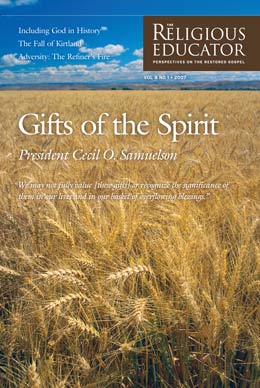Lorin Farr, Friend of the Prophet
David J. Farr
David J. Farr, “Lorin Farr, Friend of the Prophet,” Religious Educator 8, no. 1 (2007): 61–68.
David J. Farr was an insurance agent and financial planner when this was written. He is also the author of three books on Farr family history. He lives in Mission Viejo, California.
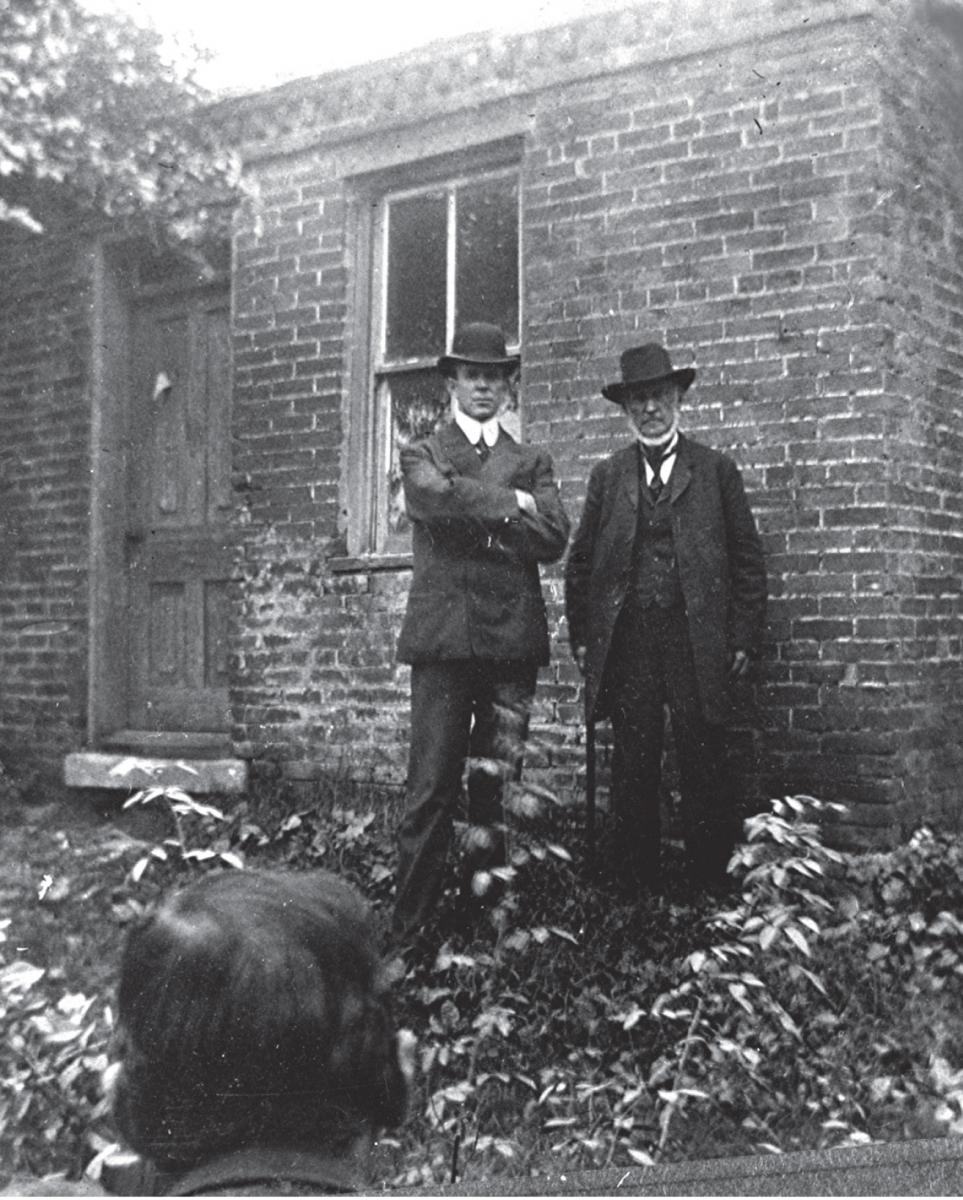 German Ellsworth (left) and Lorin Farr. This photo was taken in front of Lorin Farr's old home in Nauvoo, Illinois, September 30, 1905. Lorin did the carpentry on the house himself.
German Ellsworth (left) and Lorin Farr. This photo was taken in front of Lorin Farr's old home in Nauvoo, Illinois, September 30, 1905. Lorin did the carpentry on the house himself.
Photos courtesy of Church Archives unless noted.
The year 2005 was a landmark year in Church history. We celebrated the Prophet Joseph Smith’s two hundredth birthday on December 23. On that day, President Gordon B. Hinckley spoke at the Prophet’s birthplace in Sharon, Vermont, to commemorate that historic event. Many other events and publications throughout the year reminded us of the remarkable life of the Prophet of the Restoration.
In 1905, the Church commemorated the one hundredth birthday of Joseph Smith by erecting a large granite monument in Sharon. The dedication of the monument was attended by Smith relatives and guests. A less-noted yet significant event also occurred in that year when a sizable group of Latter-day Saint leaders, missionaries, and special guests visited Nauvoo, Illinois. I will look at these two 1905 events through the eyes of Lorin Farr, who was present at both. Lorin Farr was an early associate of Joseph Smith and was called by Brigham Young to lead the settlement of Weber, Utah.
Lorin Farr was born July 27, 1820, in Lower Waterford, Vermont. The Farr family joined the Church in Charleston, Vermont, in 1832 as a result of the preaching of Orson Pratt and Lyman Johnston. The high point of the Farrs’ conversion was the instant healing of Lorin’s mother, Olive, by the young missionary Orson Pratt. Olive had been sick for five years, and her doctors expected her to die. After her healing, though, she lived until age ninety-four, outliving Orson Pratt.[1]
The Farrs left Charleston in 1837 to join the Saints in Kirtland, Ohio. From there they went through all the joys and hardships that Saints typically experienced en route to Utah. Lorin Farr lived with and became well acquainted with the Prophet Joseph Smith while in Missouri. Lorin taught the Smith children and other Mormon families in the area. He was a bodyguard, scribe, and good friend to the Prophet. Emma and Joseph referred to Lorin as their “boy,” and Lorin said of Joseph, “I know him to have been a great, good and true man, and one who never betrayed his trust.”[2]
While Lorin was serving a mission to Europe, the Millennial Star reported at a conference in Glasgow, Scotland, that “Elder Farr had been with the church 39 years, and was associated with Joseph Smith more or less up to the time of his death. He had ridden with him, and [lodged] with him, and knew that he was a good man, a worthy man, and an exemplary man in all things.”[3] Lorin had been Joseph’s bodyguard, walking by his side with gun and sword and sleeping outside the Smiths’ door at night when needed. Lorin was part of the Smith household: he wrestled with the Prophet, ran races with him, and became his full-fledged chum. He was with Joseph at the time of the Haun’s Mill Massacre and at Adam-ondi-Ahman.[4]
After leaving Nauvoo in 1845, Lorin served as the first president of the Weber Stake and as mayor of Ogden, Utah.[5] Throughout his life, he bore testimony of Joseph whenever he could. As the year 1905 came, Lorin Farr must have reflected more than ever on Joseph Smith’s birth, his accomplishments, and the impact that Joseph had on Lorin. At eighty-five years old, Lorin was one of the few people living who had personally known the Prophet.
In a special Deseret News dispatch, Lorin Farr reported that he left Ogden for Nauvoo on September 20, 1905. After some sixty years of absence, Lorin attended the first missionary conference held in the City of Joseph since the 1845 exodus. According to the local newspaper, the Nauvoo Independent, which was quoted extensively by the Deseret News, he was among an increasing number of Latter-day Saints to visit the city, which once had twenty thousand inhabitants but had dwindled to fourteen hundred. Vineyards and apple orchards grew where homes once stood. The current residents welcomed visitors from the West in hopes that the neglected city would be revitalized.
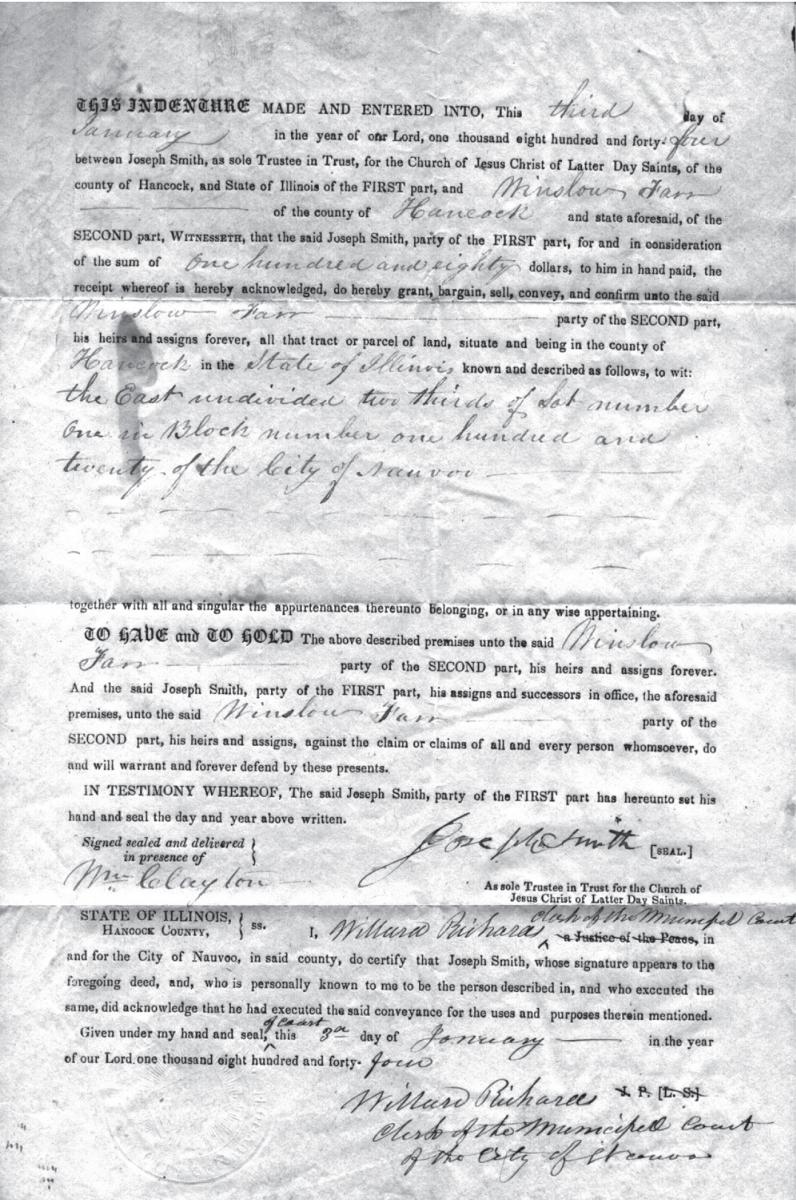 Deed to Winslow Farr's property (father of Lorin Farr), Nauvoo, Illinois, signed by the Prophet Joseph Smith, William Clayton, and Willard Richards. Courtesy of L. Tom Perry Special Collections, Harold B. Lee Library.
Deed to Winslow Farr's property (father of Lorin Farr), Nauvoo, Illinois, signed by the Prophet Joseph Smith, William Clayton, and Willard Richards. Courtesy of L. Tom Perry Special Collections, Harold B. Lee Library.
Lorin reported how the minds of the people had changed. “All [the people] that I saw seemed to be pleased to see me, and I was never treated better than by the people of Nauvoo. . . . They are very friendly to our people. . . . There were in attendance about 50 missionaries mostly from Illinois . . . and quite a number of sisters, some of them missionaries. We had a splendid meeting on Sunday: it seemed like old times when we used to have our conference in the days of the Prophet Joseph Smith. In fact I never enjoyed a meeting much better than we had there. All of the people I talked with were anxious to have our people come back there and live there. . . . I told them that most of the people that were men and women when we left 60 years ago were not living.”[6]
The Nauvoo Rustler of October 3 reports that Lorin Farr visited the brick house his family had owned while in Nauvoo. This home was owned by someone else then, although Lorin still had the deed to the house.[7]
The visit of the missionaries was the first active proselyting work done by the Church in Hancock County since 1845. As the elders came into Nauvoo on September 29, they were warmly welcomed and given lodging in homes originally owned by Brigham Young, Heber C. Kimball, and others. Meetings were held in the city hall, which was on the same block a few feet from where the temple once stood. In fact, the city hall had been built in part from the rock used in the temple construction. The mayor granted the visitors all the privileges necessary for their preaching. On the evening of the twenty-ninth, they held a meeting on Mulholland Street, sang a few songs, and invited the people to attend the meetings to be held over the next few days. The first meeting was well attended. It was a fast and testimony meeting, as it was the first Sunday of the month. They were privileged to meet in the Nauvoo House, which stands on the banks of the Mississippi River. There was a beautiful view of the placid waters of the Mississippi River sparkling in the early morning sunlight. Rain the night before had cleared the air for this wonderful sight. The visitors could hardly comprehend the friendly and warm feelings exhibited by the inhabitants of Nauvoo, where once such bitterness prevailed. A beautiful spirit was manifested throughout the conference, making a deep and lasting impression on everyone there. Many said that they had never experienced such exquisite happiness as they did during this visit to Nauvoo. Most had never enjoyed such an outpouring of brotherly love and the Spirit of the Lord.[8]
In a meeting at the Mansion House, Lorin Farr captured the attention of his listeners by stating that the trials of the Saints who were driven from Nauvoo were a pleasure because God was preparing His people for the future. Lorin’s age, vigor of body, white locks, honest countenance, testimony, and Christlike attitude toward the people made quite an impression. His testimony of the divine mission of Joseph Smith rang with the tone of one who knew. He said that they would not quarrel with any man, so when people became abusive and quarrelsome, the Latter-day Saints moved west.[9]
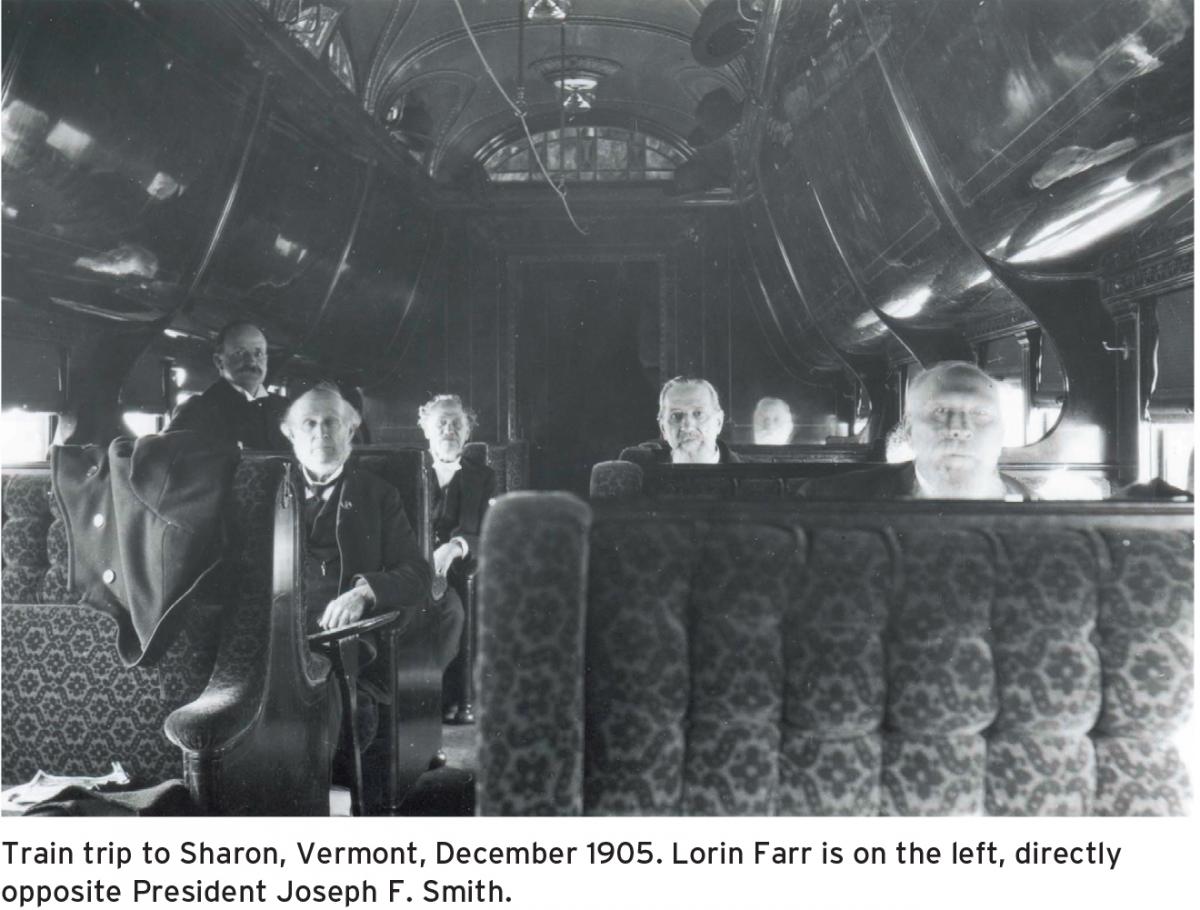
During the 1905 conference, Lorin made a prediction that would be realized a century later: “I thought some time in the near future many of the Latter-day Saints would come and assist in the building of a beautiful city, as I considered that Nauvoo is one of the prettiest sites or locations for a city lying [on] the Mississippi River.” [author: please provide source for quote; also, verify the correctness of our bracketed “on”] Today, a century after that prediction, Nauvoo includes the rebuilt temple, many other restored buildings, and a strong, growing Latter-day Saint presence.
The gathering at Nauvoo was a prelude to the historic journey to Sharon, Vermont, in December 1905 to dedicate the granite monument honoring the one hundredth anniversary of Joseph Smith’s birth. Lorin Farr was invited by President Joseph F. Smith to travel with a party of thirty prominent Church members to Sharon. They departed on December 18. Lorin was in the company of his son-in-law, John Henry Smith, and his grandson, George Albert Smith, both members of the Quorum of the Twelve. George Albert Smith was in charge of the details of the trip, as he was the newest member of the Twelve. The party visited the birthplace of Hyrum Smith in Tunbridge, Vermont, and then visited the Joseph Smith Sr. farm. The group celebrated with music and speeches as they visited various sites. The biggest event was the raising and dedication of the Joseph Smith Monument. Junius Wells, project chairman and inspired instigator for the monument, told of locating stone for the monument, moving its sixty tons for polishing and cutting, and then transporting it by rail and wagon to the current site.[10]
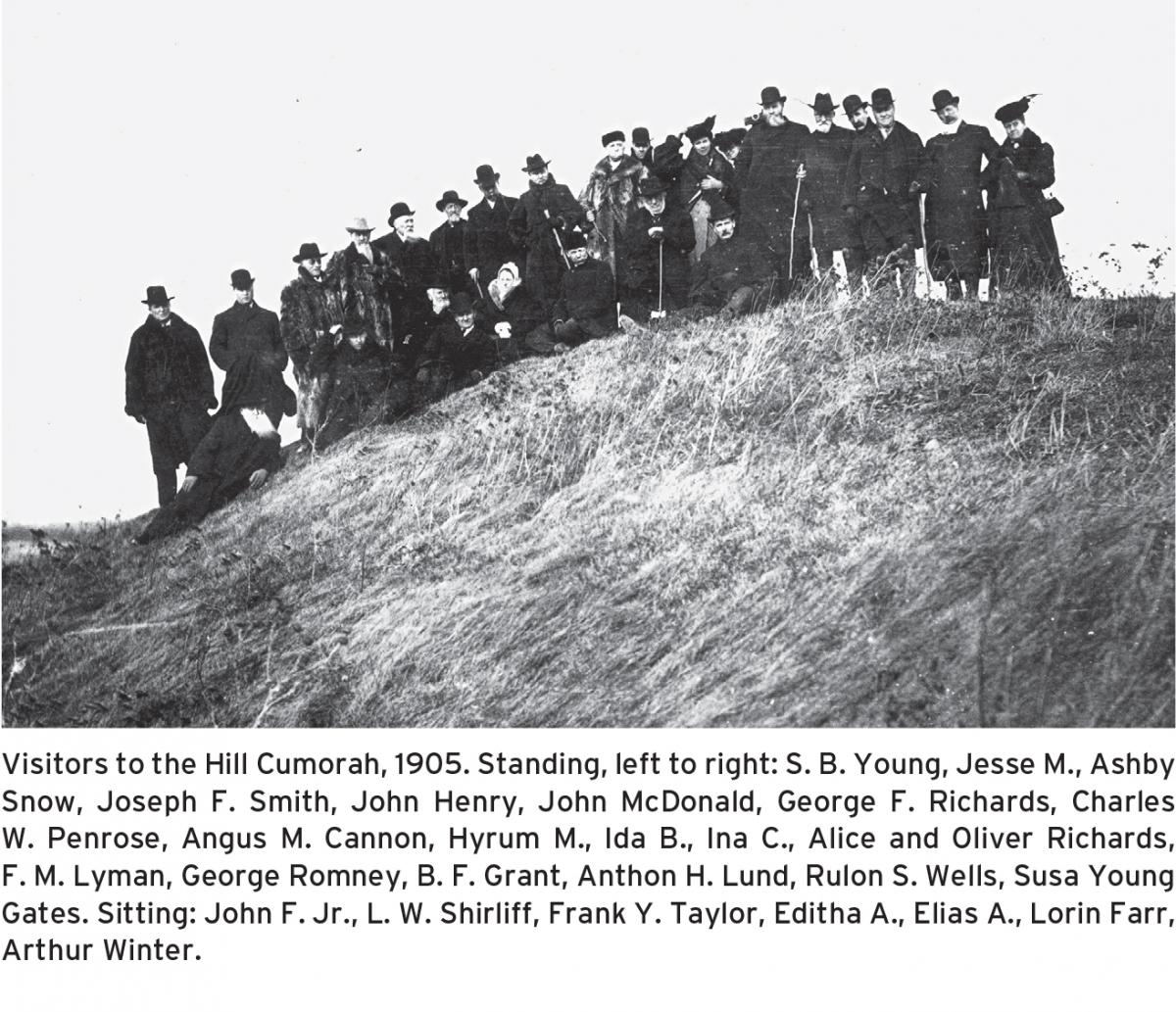
From there, they visited Boston and then traveled to Palmyra to visit the Smith farm and the Sacred Grove. On this trip, they finalized the purchase of the Mack farm in Vermont and began the process to purchase the Smith farm, the Sacred Grove, and the nearby Hill Cumorah. George Albert Smith, Lorin’s grandson, played a vital role in acquiring these properties, having developed relationships with the owners of these important historic sites. The trip lasted through the beginning of January 1906. During the entire trip, they held evening services with song and prayer. They had a testimony meeting on New Year’s Eve where all members of the party, including Lorin, expressed their feelings. It was a warm, wonderful, and sentimental trip for those involved. By the time they arrived back in Salt Lake City, they had traveled fifty-five hundred miles.[11]
In 1905, Lorin Farr was one of the last living witnesses of the life of the Prophet Joseph Smith. He testified with clarity and power that the Prophet was who he said he was and that his testimony and teachings are valid for the ages.
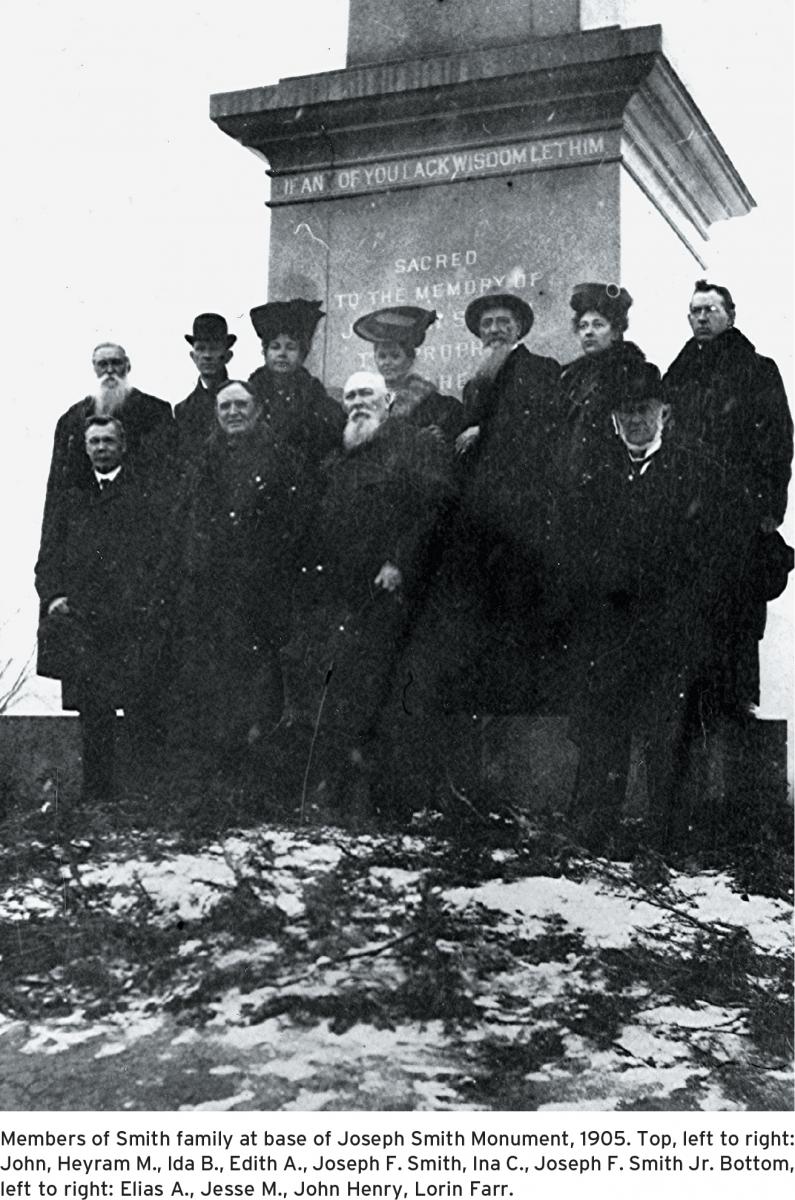
Notes
[1] David J. Farr, Winslow and Olive Farr (Mission Viejo, CA: Winslow Farr Sr. Family Organization, 1993), 19–20.
[2] John Farr, quoted in T. Earl Pardoe, Lorin Farr, Pioneer (Provo, UT: Brigham Young University Press, 1953), 49; see also 51–53, 69, 72, 310–11.
[3] Quoted in Pardoe, Lorin Farr, Pioneer, 206.
[4] John Farr, quoted in Pardoe, Lorin Farr, Pioneer, 49.
[5] John Hart, “Return of an Exile,” Deseret News, November 19, 2005, 7.
[6] “Utah Mormons Visit Nauvoo,” Deseret News, October 16, 1905; see also Pardoe, Lorin Farr, Pioneer, 304–5.
[7] Deseret News, October 16, 1905. That deed, received by the Winslow Farr Sr. Family Organization, was sold to the L. Tom Perry Special Collections at Brigham Young University in Provo, Utah. Curt Bench, a rare documents dealer and owner of Benchmark Books in Salt Lake City, said it was worth $8,500 in 2003.
[8] Deseret News, October 3, 1905.
[9] Deseret News, October 3, 1905.
[10] Joseph Fielding Smith, The Life of Joseph F. Smith (Salt Lake City: Deseret News, 1938), 355–72. For a detailed description of Junius Wells’s efforts in erecting the monument, see his speech at the dedication in Smith, Life of Joseph F. Smith, 358–60. For an article on the Joseph Smith Memorial, see Darel P. Bartschi, “The Joseph Smith Memorial: A 1905 Tribute to the Prophet and His Work,” Ensign, February 1988, 7.
[11] Smith, Life of Joseph F. Smith, 3. For a description of George Albert Smith’s role in planning the trip and his subsequent arrangements for the purchase of Church historic sites, see Francis M. Gibbons, George Albert Smith: Kind and Caring Christian, Prophet of God (Salt Lake City: Deseret Book, 1990), 50–53.
